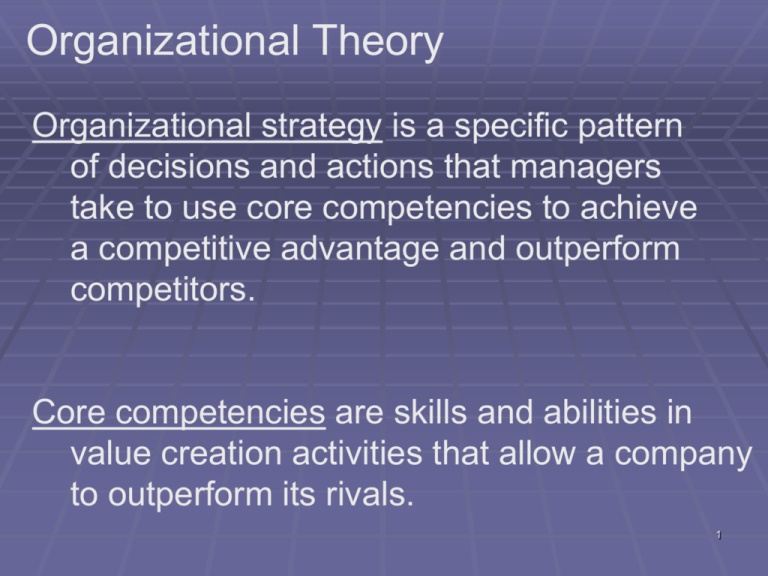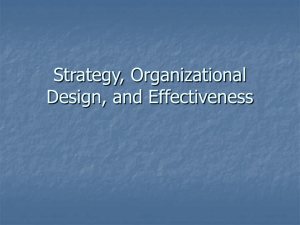Global product group structure
advertisement

Organizational Theory Organizational strategy is a specific pattern of decisions and actions that managers take to use core competencies to achieve a competitive advantage and outperform competitors. Core competencies are skills and abilities in value creation activities that allow a company to outperform its rivals. 1 Organizational Theory Table 8-1 Low-Cost and Differentiation Advantages Resulting from Functional-Level Strategy Value-creating function Source of low-cost advantage Source of differentiation advantage Manufacturing • Development of skills in flexible manufacturing technology • Increase in product quality and reliability Human resource management • Reduction of turnover and absenteeism • Hiring of highly skilled personnel • Development of innovative training programs Materials management • Use of just-in-time inventory • Use of company reputation system/ computerized warehousing and long-term relationships with suppliers and customers • Development of long-term to provide high-quality inputs relationships with suppliers and and efficient distribution and customers disposal of outputs 2 Organizational Theory Table 8-1 Low-Cost and Differentiation Advantages Resulting from Functional-Level Strategy (continued) Value-creating function Source of low-cost advantage Source of differentiation advantage Sales and marketing • Increased demand and lower production costs • Targeting of customer groups • Tailoring products to customers • Promoting brand names Research and development • Improved efficiency of manufacturing technology • Creation of new products • Improvement of existing products 3 FIGURE 8-3 Structural Characteristics Associated with the Development of Core Competencies in Production, Sales, and Research Development Manufacturing Sales R&D Mechanistic structure Organic structure Manufacturing Sales R&D Tall organization Flat organization Manufacturing Sales R&D Centralized decision making Decentralized decision making Manufacturing Sales R&D Standardization Mutual adjustment 4 . Organizational Theory Once an organization has chosen its domain, it can use either of the following: Low-cost business-level strategy— produces low-priced goods and services for all customer groups. Differentiation business-level strategy— produces high-priced, quality products aimed at particular market segments. 5 Organizational Theory One type of business-level strategy is the focus strategy. Focus strategy involves specialization in one segment of the market and focusing all of the organization’s resources on that segment. 6 FIGURE 8-5 Characteristics of Organizational Structure Associated with Business-Level Differentiation and Low-Cost Strategies Matrix Product team Product, market, Functional structure structure or geographic structure structure Differentiation Strategy Low-Cost Strategy Complex structure Simple structure Decentralized decision making Centralized decision making High differentiation Low differentiation High integration Low integration Organic structure Mechanistic structure 7 FIGURE 8-6 Corporate-Level Strategies for Entertaining New Domains Input Domains Backward vertical integration Related diversification Related Domains Core Domain Output Domains Forward vertical integration Unrelated diversification Unrelated Domains 8 Organizational Theory Organizations pursuing a strategy of unrelated diversification are likely to use a conglomerate structure. Conglomerate structure—a structure in which each business is placed in a self-contained division and there is no contact between divisions. 9 FIGURE 8-8 Conglomerate Structure CEO Corporate Headquarters Staff A Division B Division C Division D Division E Division F Division G Division H Division I Division 10 11 12 Organizational Theory Multidomestic Strategy Pressures for Local Responsiveness HIGH Pressures for Global Integration LOW • Manufacturing, R&D, marketing abroad • Achieve a differentiation advantage • Bureaucratic costs are lowest 13 Organizational Theory International Strategy Pressures for Local Responsiveness LOW Pressures for Global Integration LOW • Manufacturing abroad • R&D and marketing at home • Bureaucratic costs are low 14 Organizational Theory Global Strategy Pressures for Local Responsiveness LOW Pressures for Global Integration HIGH • Manufacturing at a few low-cost locations • R&D and marketing at home • Bureaucratic costs are high 15 Organizational Theory Transnational Strategy Pressures for Local Responsiveness HIGH Pressures for Global Integration HIGH • Manufacturing, R&D, marketing abroad, BUT • Emphasis on global learning / cost reduction • Bureaucratic costs are highest 16 Organizational Theory Vertical differentiation choices Levels in the hierarchy Low Need for Coordination High Multidomestic Strategy International Strategy Global Strategy Transnational Strategy Relatively flat Relatively tall Relatively tall Relatively flat Low Bureaucratic Costs High 17 Organizational Theory Vertical differentiation choices Centralization of authority Low Need for Coordination High Multidomestic Strategy International Strategy Global Strategy Transnational Strategy Decentralized Centralized / Decentralized Centralized Simultaneous Centralized & Decentralized Low Bureaucratic Costs High18 Organization Theory Horizontal differentiation Type of Structure Low Need for Coordination High Multidomestic Strategy International Strategy Global Strategy Global geographic structure Global product group structure Global Global matrix product group structure Low Bureaucratic Costs Transnational Strategy High19 Organizational Theory Global geographic structure — a structure in which foreign divisions are created in every country or region in which an organization operates to replicate all its domestic value creation activities. 20 FIGURE 8-9 Global Geographic Structure Corporate Headquarters (located in Sweden) Canadian United British French Japanese South Division States Division Division Division American Division Division Functional activities 21 Organizational Theory Global product group structure — a structure in which product group headquarters coordinates the activities of the domestic and foreign divisions within each product group. 22 FIGURE 8-10 Global Product Group Structure Corporate Headquarters (located in the United States) Worldwide Chemicals Worldwide Consumer Worldwide Automotive Product Group Goods Product Product Group Headquarters Headquarters Headquarters Canadian British United States French Japanese Division Division Division Division Division Product groups Domestic and foreign divisions 23 Organizational Theory Global matrix structure — a structure that coordinates organizational activities and resources along two dimensions: • • Product groups and World areas 24 FIGURE 8-11 Global Matrix Structure North American Area Canadian Division Mexican Division United States Division European Area British Division French Division Pacific Area Japanese Division Taiwan Division Chemicals product group Consumer goods product group Automobile product group Individual business division 25 “GM Unveils Overhaul of Europe Operations” General Motors unveiled much-anticipated overhaul of European operations designed to streamline Co by bringing units Adam Opel, Vauxhall Motors, and Saab under single mngt structure Intended to speed up decision making and increase efficiency Centralizing finance, design and engineering, buying, manufacturing, sales and marketing “Asking all of our European ees to recalibrate themselves to a mindset of working for General Motors overall, instead of an individual brand or country operation” Source: Wall Street Journal, 6/18/04 See also “Reversing 80 Years of History…” 26 “International Isn’t Just IBM’s First Name” Lotus Symphony is package of PC software applications Work on new version started in July 2007 Teams in Beijing (lead); Austin, TX; Raleigh, NC; Boeblingen, Germany contributing One of major challenges is difficulty of communicating via e-mail or videoconferencing when programmers have never met one another Trust is big problem IBM trying to bridge gap w/ software that borrows heavily from social networking New program called Beehive is essentially corporate version of Facebook Ees create profiles and post photos, lists of interests, etc. Source: Business Week, 1/28/08 27




